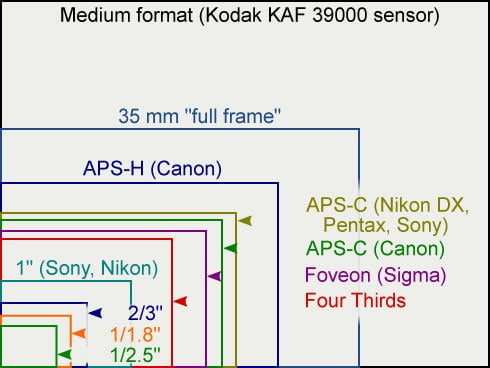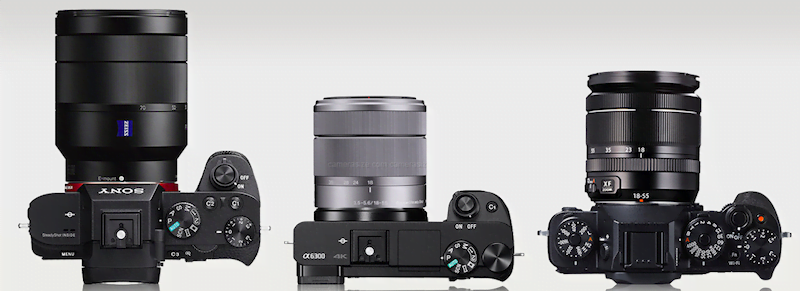Disclosure: This post may contain affiliate links. I earn a small commission of product sales to keep this website going.
Ten years ago I would have scoffed at APS-C sensors. Amateurs. Pros use full-frame sensors and nothing else. Therefore I only looked at cameras with full-frame sensors. I didn’t really know the differences between full-frame sensors and APS-C sensors, I just knew that pros used full-frame and that’s all I cared about because that’s what I was told by people selling cameras.
In my “choosing a travel camera” article I touched a little bit on how my “needs versus wants” changed over the course of my career. And I saw that my long-held beliefs about full-frame vs. APS-C weren’t right.
I wasn’t printing giant wall murals. I would print a 12″x18″ every now and then but I was mostly selling stock photos for magazines & digital publications.
A number of these were made with the APS-C Sony a6000 & a6300 because I liked traveling with those smaller cameras. I made these sales based on the image, not the sensor.
Just take a look at Ken Kaminesky. This dude has had a few National Geographic covers. He’s a Fujifilm X-Photographer, one of the elite brand ambassadors for Fujifilm. He was one of the first to field test the X-T2, a 24MP APS-C mirrorless camera, after regularly using the 16MP X-T1.
I’ll answer the question now: No, full-frame sensors are not “better” than APS-C sensors. They generally have more capability, but does that matter to what you do?
What are the differences between Full Frame and APS-C sensors?
Don’t confuse megapixels, or pixel count, with sensor size.
Sensor size is the physical dimensions of the sensor, not how many pixels are on the sensor.
- A full-frame sensor measures 36mm x 24mm – the traditional size for 35mm cameras.
- An APS-C sensor size is smaller, measuring 23.6mm x 15.7mm.
You can have both a 16-megapixel full-frame camera and a 24-megapixel APS-C camera. The smaller APS-C sensor in this example crams a lot more pixels onto that smaller space. Which isn’t always better.

Advantages of Full Frame vs APS-C
Better light sensitivity & dynamic range
So we’ve established that full-frame sensors are physically larger than APS-C sensors.
Say you have a 24MP camera. What happens when you take the 24 million pixels on a full-frame sensor and cram them onto an APS-C sensor? You have to shrink the pixels to fit them in this smaller space.
Think of these pixels as buckets, that’s a common analogy. If you put 24 million buckets on a full-frame sensor then they can be physically larger than the 24 million buckets on an APS-C sensor. There’s just more room for them.
That means that they can collect more water – or in this case, light. If you have a given pixel count, those pixels will be able to gather more light on a full-frame sensor than they would be able to on an APS-C sensor.
This is why most full-frame cameras have a higher dynamic range than APS-C sensors – the pixels are usually larger, thus they can give you a larger tonal range.
There are some APS-C cameras, however, that have a higher dynamic range than their full-frame counterparts due to technological advances.
It’s not about the size of the sensor, it’s about the size of the pixel and the technology associated with it.
Shallow depth of field
I didn’t even want to bring this up because it can get messy with all the math.
Yes, the same 50mm f/1.8 lens will have a different hyperfocal distance between a full-frame camera and an APS-C camera. You’ll get a shallower depth of field – or background blur – out of the full-frame camera.
But it’s apples and oranges by this point. You can still get an incredibly shallow depth of field with an APS-C camera, it just takes a different lens.
Accurate fields of view & wide lenses
A 50mm lens on a full-frame camera has a field of view of what you’d expect for a 50mm lens. There’s no conversion involved.
An APS-C camera crops the image by, normally, 1.5x. So that 50mm lens will give you an apparent focal length of roughly 75mm on an APS-C camera. However, the physical focal length is still 50mm.
Now think about this in regards to that 16mm super-wide lens you bought for those amazing skyscapes. Put that lens on an APS-C camera and now you have a perspective equal to a 24mm lens. It’s wide, but not the super-wide view you bought the lens for.
In fact, it’s tough to find super-wide lenses for APS-C cameras because of this crop factor.
Higher resolution
Because of the larger image area and the larger lens in front of it, you’ll generally get higher resolution with full-frame cameras. And I’m talking about zooming way in and looking at all the fine details.
Have you tried zooming in on images from a compact point-and-shoot or a compact drone that uses a 1/2.3″ sensor? Yeah, they’re crap when zoomed in because the sensors are about the size of a fingernail, not a Post-It note.
If you’re a pixel-peeper, this will be important to you. If you just want to get published in some magazines, it doesn’t matter.

Advantages of APS-C vs Full-Frame
Smaller cameras & lenses
That smaller sensor doesn’t need as large of a camera body to fit in. The camera also doesn’t need to be as robust to hold those large lenses required for full-frame cameras. Thus, they can be made smaller and lighter.
APS-C sensors can also take smaller lenses. Because the image area is smaller, the overall lens can be smaller, requiring less glass.
All of this will cut down on the weight of the camera and lens.
Lower costs
The sensor is one of the most expensive things in a camera.
So it should go without saying that the smaller one is cheaper to produce (given it has the same technology).
And as we just saw, the camera bodies and lenses can be smaller. This generally means that they will be cheaper too, barring some other kind of super-fancy technology found on the camera.
Zoom your lenses
This was a disadvantage to APS-C cameras in the previous section, and it’s an advantage here.
A 300mm lens for a full-frame camera is going to be large and expensive. To get that same equivalent focal length on an APS-C camera you only need a 200mm lens because the crop factor will multiply it.
Oh, and that lens will also be cheaper and smaller because it’s for an APS-C camera.
Deeper depth of field
Landscape photographers will be able to get more foreground & background elements in focus at larger apertures thanks to the effects of depth of field, which was previously a disadvantage for those looking for an extremely shallow depth of field.
Conclusion
I’m not trying to talk you into APS-C cameras or say that they’re better than full-frame cameras in general.
There are certainly photographers who, based on their business, need full frame vs APS-C. Or you just have a thing for full-frame cameras. That’s totally fine, I did too for the longest time.
All I’m trying to say is that generally, for travel photography, I’d argue that an APS-C sensor will meet your needs. And there are a number of good ones for under $500. In fact, if you don’t regularly make prints larger than 36 inches, an even smaller micro four-thirds sensor might do you just fine.
For those of you who still say, you need a full-frame camera because APS-C sensors are inferior, then let me ask you, why don’t you get a medium-format camera because full-frame sensors are inferior to those?
If you haven’t considered an APS-C camera because of the things you’ve heard from armchair photographers in the forums, I’d urge you to consider them.
And remember that when someone looks at your pictures in magazines, they won’t be asking, “I wonder what sensor size they used.” They’ll just be awed by the photo because you’re a good artist who can make the best of the camera you have.
What are your thoughts on all this? Please leave them below!

Pete
Tuesday 23rd of January 2024
So….
Do I take my Canon 5d mk4 or my Canon 90d to Thailand on holiday????
John Peltier
Tuesday 23rd of January 2024
Both! Never hurts to have a backup body :)
Tim Smith
Saturday 24th of September 2022
I have been enjoying an APS-C camera since taking on my love of wildlife photography 3 years ago. I like what you said about a person who sees a beautiful image in a magazine or printed on metal as I have made is simply impressed with the image rather than being compelled to question about the sensor size. I have had images produced up to 24x36 inches, and I am known for my finely detailed photography in the gallery where I display my work. I am a strange thing being a low budget photographer, especially using a super telephoto lens. I bought my camera and lenses used, and I prefer usually going without a tripod to take advantage of mobility for the changing elements in wildlife photography. But I hold still for long periods of time, waiting for that amazing compelling moment to happen. So I need to go as light as possible. My Canon T7i and old version Canon 100-400 is perfect for me at about 4 pounds while giving me the equivalent of 640 mm at under $1,100 for the pair. People tell me that I have to go full frame for the best image quality, yet I have never had anyone who has seen my work say that.
John Peltier
Sunday 25th of September 2022
Sounds like you're a perfect example of why sensor size doesn't matter as a general statement. Keep using the gear that helps you get the job done :)
Rodney Johnson
Friday 12th of August 2022
Great article! I am now going to look for a decent medium format camera under $50,000.
randy
Sunday 15th of May 2022
Thanks for information.
Seb
Sunday 6th of February 2022
Is would be nice to see comparaison between example sony a6400 and sony a7C picture they have the same pixel range … honestly i wonder if i should upgrade my camera to have beter picture in low light or i shoud wait to get a senso with more mpx
Matt
Friday 11th of February 2022
@Seb, "… honestly i wonder if i should upgrade my camera to have beter picture in low light or i shoud wait to get a senso with more mpx"
That's not a hard decision to make. Let us know what you like to shoot most of the time, sports, wildlife, street, portraits, landscape etc. and we can help you decide once we know what you are looking for. Do you shoot at night or dusk and dawn ever? High speed action and sports? Birds? Depending on your skill level you might find some educational videos or other a workshop and even better use of your money to learn some new skills and techniques...almost always a better use of your money.